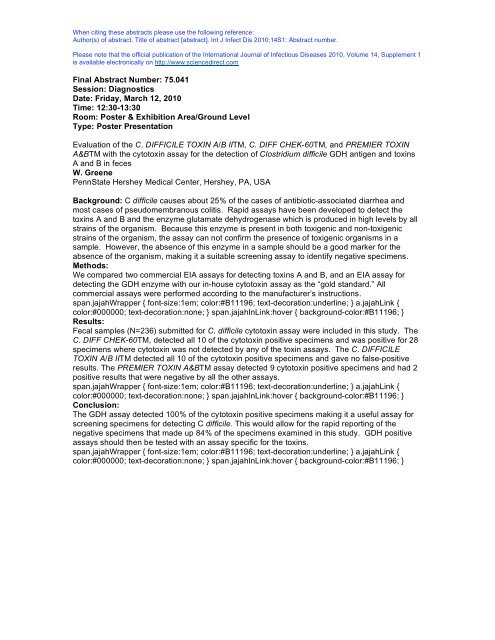14th ICID - Poster Abstracts - International Society for Infectious ...
14th ICID - Poster Abstracts - International Society for Infectious ...
14th ICID - Poster Abstracts - International Society for Infectious ...
Create successful ePaper yourself
Turn your PDF publications into a flip-book with our unique Google optimized e-Paper software.
When citing these abstracts please use the following reference:<br />
Author(s) of abstract. Title of abstract [abstract]. Int J Infect Dis 2010;14S1: Abstract number.<br />
Please note that the official publication of the <strong>International</strong> Journal of <strong>Infectious</strong> Diseases 2010, Volume 14, Supplement 1<br />
is available electronically on http://www.sciencedirect.com<br />
Final Abstract Number: 75.041<br />
Session: Diagnostics<br />
Date: Friday, March 12, 2010<br />
Time: 12:30-13:30<br />
Room: <strong>Poster</strong> & Exhibition Area/Ground Level<br />
Type: <strong>Poster</strong> Presentation<br />
Evaluation of the C. DIFFICILE TOXIN A/B IITM, C. DIFF CHEK-60TM, and PREMIER TOXIN<br />
A&BTM with the cytotoxin assay <strong>for</strong> the detection of Clostridium difficile GDH antigen and toxins<br />
A and B in feces<br />
W. Greene<br />
PennState Hershey Medical Center, Hershey, PA, USA<br />
Background: C difficile causes about 25% of the cases of antibiotic-associated diarrhea and<br />
most cases of pseudomembranous colitis. Rapid assays have been developed to detect the<br />
toxins A and B and the enzyme glutamate dehydrogenase which is produced in high levels by all<br />
strains of the organism. Because this enzyme is present in both toxigenic and non-toxigenic<br />
strains of the organism, the assay can not confirm the presence of toxigenic organisms in a<br />
sample. However, the absence of this enzyme in a sample should be a good marker <strong>for</strong> the<br />
absence of the organism, making it a suitable screening assay to identify negative specimens.<br />
Methods:<br />
We compared two commercial EIA assays <strong>for</strong> detecting toxins A and B, and an EIA assay <strong>for</strong><br />
detecting the GDH enzyme with our in-house cytotoxin assay as the “gold standard.” All<br />
commercial assays were per<strong>for</strong>med according to the manufacturer’s instructions.<br />
span.jajahWrapper { font-size:1em; color:#B11196; text-decoration:underline; } a.jajahLink {<br />
color:#000000; text-decoration:none; } span.jajahInLink:hover { background-color:#B11196; }<br />
Results:<br />
Fecal samples (N=236) submitted <strong>for</strong> C. difficile cytotoxin assay were included in this study. The<br />
C. DIFF CHEK-60TM, detected all 10 of the cytotoxin positive specimens and was positive <strong>for</strong> 28<br />
specimens where cytotoxin was not detected by any of the toxin assays. The C. DIFFICILE<br />
TOXIN A/B IITM detected all 10 of the cytotoxin positive specimens and gave no false-positive<br />
results. The PREMIER TOXIN A&BTM assay detected 9 cytotoxin positive specimens and had 2<br />
positive results that were negative by all the other assays.<br />
span.jajahWrapper { font-size:1em; color:#B11196; text-decoration:underline; } a.jajahLink {<br />
color:#000000; text-decoration:none; } span.jajahInLink:hover { background-color:#B11196; }<br />
Conclusion:<br />
The GDH assay detected 100% of the cytotoxin positive specimens making it a useful assay <strong>for</strong><br />
screening specimens <strong>for</strong> detecting C difficile. This would allow <strong>for</strong> the rapid reporting of the<br />
negative specimens that made up 84% of the specimens examined in this study. GDH positive<br />
assays should then be tested with an assay specific <strong>for</strong> the toxins.<br />
span.jajahWrapper { font-size:1em; color:#B11196; text-decoration:underline; } a.jajahLink {<br />
color:#000000; text-decoration:none; } span.jajahInLink:hover { background-color:#B11196; }
















